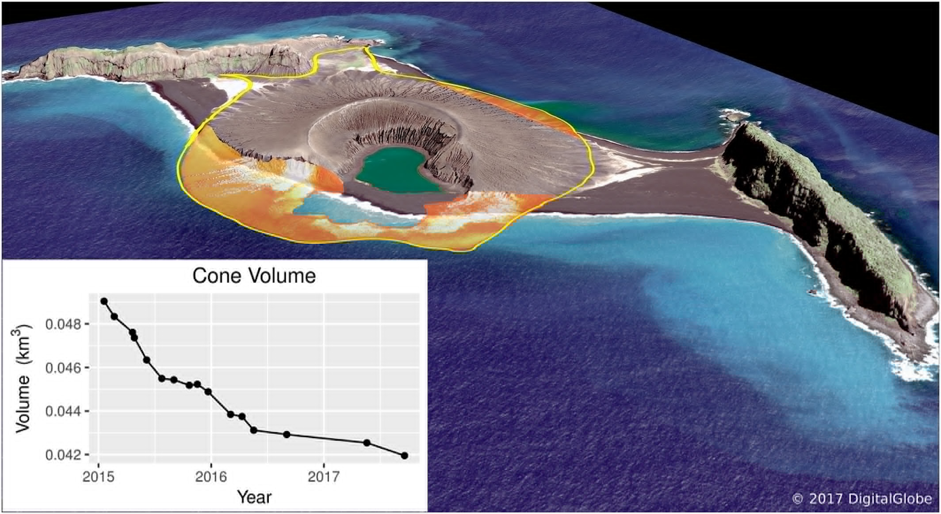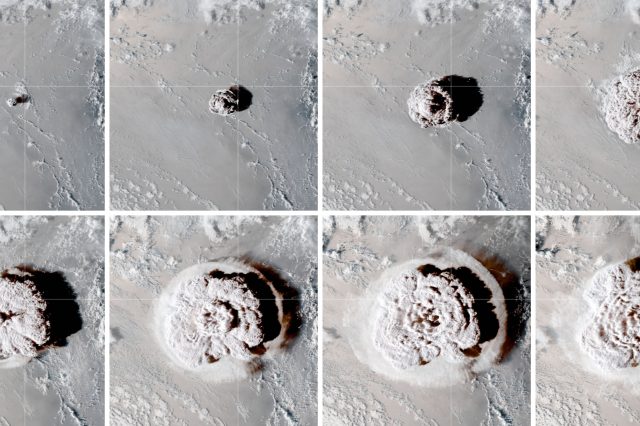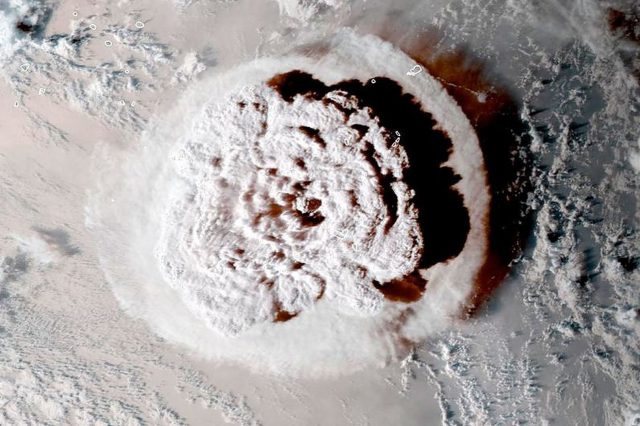A powerful explosion that sent shockwaves around the world.
On Friday, January 14, the Hunga Tonga-Hunga Ha’apai underwater volcano erupted in the Pacific Ocean.
A column of ash and gas rose to a height of 20 kilometers, and the shock wave of the explosion was recorded by weather stations in New Zealand.
A tsunami and high tide warning have been issued throughout the entire region of the Pacific Ocean.
The Hunga Tonga-Hunga-Haapai volcano is located in the Pacific Ocean south of the equator and belongs to the Tonga archipelago. It is part of the Tonga-Kermadec island arc, which was formed as a result of the subsidence of the Pacific plate under the Indo-Australian plate.
The surface structure of the Hunga Tonga-Hunga Haapai volcano is represented by two linearly elongated islands, part of the underwater caldera. An eruption in 2014 built an isthmus between these islands with sheer walls.

The first historical volcanic eruption was observed in 1912, followed by at least three more within a century. A new cycle of Hunga-Tonga-Hunga-Haapai activity began on December 29, 2021, when a series of explosive eruptions lasting up to 30 minutes occurred. Gas plumes rose to a height of 12 kilometers above sea level and began to drift north. The ashfall was localized over the Tonga archipelago.
Tonga's Hunga Tonga volcano just had one of the most violent volcano eruptions ever captured on satellite. pic.twitter.com/M2D2j52gNn
— Colin McCarthy (@US_Stormwatch) January 15, 2022
After a two-week lull on January 14, a new explosion occurred. The interaction of magma and water formed an eruptive column with a diameter of up to five kilometers, which rose to a height of 20 kilometers. In the first hours after the eruption, up to 86,000 lightning flashes were recorded in a cloud of ash and gas. Such a “volcanic thunderstorm” is associated with the friction of ash particles.
The shock wave of the eruption was recorded by weather stations in New Zealand, 3,000 kilometers from the Tonga archipelago. 2 hours 40 minutes after the explosion, a jump in pressure was noted: within 20 minutes, the pressure first increased by four gigapascals, and then fell by almost six. Residents in Australia and New Zealand also reported explosion-like sounds, rumblings.
A first, rough estimate of #tsunami wave heights between #Tonga and #Australia.
This simulation might be an underestimation (1km resolution, unclear source mechanism -> volcano collapse/landslide, 2km³)
It can not adequately reflect complex wave patterns near the coasts. pic.twitter.com/6FWl3fob1d— Andreas Schäfer (@DrAndreasS) January 15, 2022
The TROPOMI spacecraft aboard the Sentinel-5 satellite measured the amount of sulfur dioxide in the atmosphere. As of January 15, SO 2 emissions were about 50 kilotons.
In the first hours after the eruption, the government of the Kingdom of Tonga issued a tsunami warning. The eruption of the volcano led to the formation of waves up to one meter high, which were recorded by the sensors. States in the South Pacific have also notified high tides. A tsunami warning has been issued for the US West Coast as well as Japan.
https://twitter.com/JTuisinu/status/1482243845614374915?s=20
At the moment, ash is falling over the archipelago. The Geological Survey of Tonga recommends staying indoors and making sure water tanks are covered to avoid ash contamination. The organization also asks people not to go into the ocean due to strong coastal currents caused by the volcanic eruption.
Join the discussion and participate in awesome giveaways in our mobile Telegram group. Join Curiosmos on Telegram Today. t.me/Curiosmos
Sources:
• Francis, E., Parker, C., & Pannett, R. (2022, January 16). Underwater Pacific Volcano sends tsunami waves to Tonga, cutting off contact with Outer Islands. The Washington Post.
• The Guardian. (2022, January 16). Tsunami from Tonga Volcano Eruption leaves trail of flood damage.
• Khan, A. J. (2022, January 15). Underwater volcano erupts, setting off tsunami warnings across Pacific. The New York Times.
• Menon, P. (2022, January 16). Significant tsunami damage feared in Tonga, communications still cut. Reuters.
• Smithsonian Institution | Global Volcanism Program. (n.d.). Global volcanism program: Hunga Tonga-hunga ha’apai.



